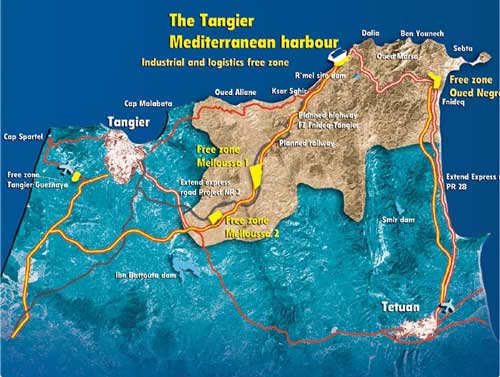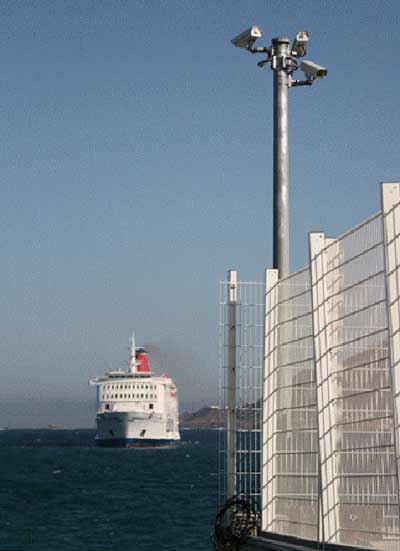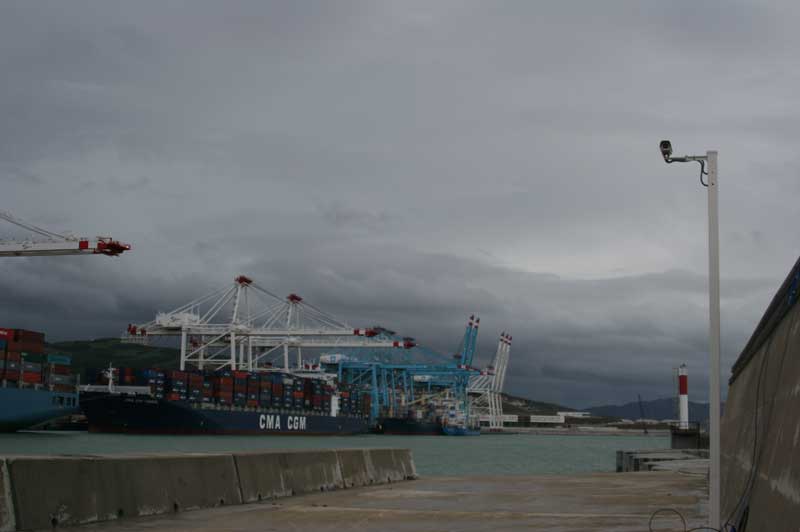An Interview With Emmanuel Villers
04/01/2011 – TangerMed is the evolving port complex in Morocco which is providing a new global capability for global trade. As The Economist put it in a 2008 article on the Mediterranean economies,
Look southward from the southern tip of Spain, across the strait of Gibraltar. There, only 14km (nine miles) away through the slight sea haze arises the vast construction works of a new seaport to the east of Tanger in northern Morocco.
TangerMed opened its first docks last July (2007). Handling 3.5m containers a year, it is already as big as Felixstowe, Britain’s biggest port. A second terminal opens this summer, and within seven years its annual capacity will rise to 8.5m. It will be the largest container port in the Mediterranean, not far behind Europe’s biggest, Rotterdam (although merely one-third the size of the Asian giants of Singapore, Shanghai and Hong Kong). Similar ports are being finished in Algeria, Egypt, Malta and Tunisia.
One-third of the world’s container traffic already passes through the Mediterranean, bringing manufactured goods from China and South-East Asia to Europe and the east coast of America. The Moroccans, spending some €3.5 billion ($5.5 billion) on TangerMed, and others along the coast hope that if they build, a big slice of global commerce will come to their shores. Goods will arrive to be broken down into smaller loads and sent around Europe. Manufacturers will set up factories in tax-free zones planned around the docks, bring in components for assembly and serve the huge market across the water.
 (Credit: http://www.skyscrapercity.com/showthread.php?t=1227659)
(Credit: http://www.skyscrapercity.com/showthread.php?t=1227659)
Building a new port facility in such a strategic location obviously requires considerable attention to the security dimension. The entire infrastructure of the port and its maritime traffic situation requires crafting a sound security system.
The TangerMed complex is managed by the Tanger Mediterranean Special Agency (TMSA) on behalf of the Moroccan Government. Cassidian has built a trusted partnership with the TMSA since an initial contract was signed in early 2008 to work on security with the TMSA.
The partnership has entailed three core efforts.
The first was crafting architecture for TangerMed security system as a lead systems integrator (LSI) working with the TMSA. Such an approach allowed the port authorities to determine the most effective way to proceed with the security approach, rather than simply adding ad hoc systems to provide for security in a jerry built manner.
The second was to shape an approach to container security for the port, and given that a core raison d’etre of the port was to manage container ships, and especially the new giant container ships, this is a key element for secure operations of the port. Here Cassidian worked with the TMSA to determine which systems needed to be put in place for the authorities to put in place a command post with capabilities to provide for container security.
The third was to shape other security tools and capabilities to provide for close-in security capabilities to ensure an efficient protection of the port.
In late December, Second Line of Defense’s Robbin Laird sat down with Cassidian’s Emmanuel Villers to discuss the TangerMed project and the role of Cassidian in crafting a 21st century port security solution set. He is in charge within Cassidian of maritime security. The full interview will appear on the Second Line of Defense website later, but here the main points of the interview are summarized.
SLD: Could you describe the importance of the port project?
Villers: The project reflects the intent of the King of Morocco to develop the North of Morocco. It is located in a key strategic location in the Gibraltar Strait. More than 30% of global container shipping passes through the Strait. Shipping from Asia goes through the Suez Canal passes through the Mediterranean and reaches towards North and South America. The port is also at the crossroads as well of North-South shipping trade. And obviously this has great growth potential as 21st century trade.
SLD: Security is considered a high priority for the TMSA?

Villers: Security of the port is one of highest priorities for the TMSA, who has decided to entrust its security system to one integrator instead of several companies. In part, it is because of the magnitude of the investment, more than three billion euros to date. The shipping companies obviously require a high level of security. And for the TMSA, the port economy can be reliable, only if security is ensured.
SLD: I understand that you started with a comprehensive assessment for the customer. Could you describe the approach?
Villers: The first job we provided was a threat assessment for the customer. The key contribution of a lead systems integrator is not only to provide tools, but first of all to provide a security solution. And this solution needs to be efficient. The key difference here is between a system integrator and a product manufacturer. The customer wanted at the outset to look at an integrated solution, rather than just buy products separately.
TMSA understood that they have a significant range of threats, and wanted a specialist of security to shape a comprehensive and integrated solution. This was our initial and baseline role.
SLD: In effect, the project started with shaping a trusted partnership with the customer?
Villers: Yes. We worked with the customer to shape an Operational Concept (conops) to design the approach to comprehensive port security. A key challenge is to draw an approach providing comprehensive security to the various stakeholders. They are many actors ranging from Port Authority, Port Facilities, shipping companies, industries, maritime police, etc. We needed to shape an operational concept that can bring together a threat assessment plus shaping stakeholder roles in the overall concept.
SLD: When was this done?
Villers: The baseline assessment was done during year 2008. Based on this, we recommended a range of solutions to implement the conops.
There were two types of threats.
First is the safety of the shipping based on the fact that the Gibraltar strait is relatively narrow with various wind and sea conditions. A good traffic surveillance system is essential. The Cassidian VTS system is used to provide for this basic capability.
Second is the security for the port, which is challenged by various potential threats, such as thefts, illegal immigration, drug traffic, smuggling, and terrorist organizations. It is a major trans-shipment port both East – West and North – South and as such provides an attractive location for illegal and terrorist activities.

SLD: What are the major tools you are shaping for the port?
Villers: A first element we are providing is the Vessel Traffic Services (VTS) systems. And the customer operates a Control Room within which VTS operates. The main mission is to follow big vessels or container ships to provide for vessel safety, against collision for example. We have built the infrastructure for the VTS and have put SOFRELOG tools in the Control Room, which the customer then uses to provide for the safety for the large ships. The customer runs the VTS himself, but we provide training for the staffs, which are included in the global contract.
SLD: And you have a key effort beyond VTS to provide for security as well?
Villers: Yes we have a second pillar to provide for security which focuses on the malevolent threats, notably those associated with small targets. We are focused on following small boats, swimmers and individuals trying to penetrate the port from the land side.
SLD: So the customer now manages the large or container ships, and you are managing the other safety and security threats.
Villers: Not exactly. The security system is also operated by the customer. We design and deliver the port security system and this is a complex challenge. We have to manage threats from the waterside using radars, cameras and other tools to detect day and night persons seeking to penetrate the port. And we have to manage the landside as well. Meaning to take care of land perimeter of the port, with various systems integrated such as intelligent video, access control, biometric controls, truck traffic controls (truck, cargo and driver) and verification, etc. There are other systems as well such as scanners and secured communications.
And this complex and diverse effort is centralized upon a security control room whose task is to monitor security activity based on the flow of data from the various security systems. The security control room is focused on managing the data and alarms from the diverse systems to deliver good security decisions in dealing with the various threats.
All of these subsystems are integrated in the security control room, which increases efficiency while reducing the number of operators and patrol teams, then enables the port security forces to focus their attention on threats in real time.

